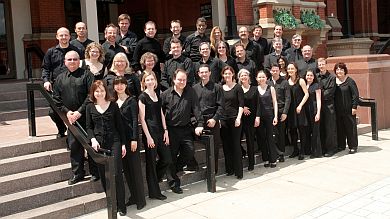
CSO Chamber Players Shine in New Venue

Cincinnati Symphony Chamber Players on the steps of Music Hall
|
Frankenfeld, associate principal violist of the CSO, joined 13 other CSO players in music by Mozart and Haydn. It was part two of the CSO’s Mozart Festival, which began earlier in the day with a CSO concert led by guest conductor Sir Roger Norrington at Music Hall.
Mayerson Theater is a comfortable venue, with seats sloped toward the back for unobstructed sight lines. The sound is clear and bright, with little or no reverberation. As such, it is unforgiving, but with these fine musicians on display, there was little to forgive. If the venue can be faulted for anything, it would be ambiance (which century-old Memorial Hall has in spades). A panel at the rear of the stage was lit in ruby tones. Otherwise it was a bare, wide-open expanse. Even a potted plant to the side might have helped the musicians look less lonely.
Of
course, it was the music that counted. The concert opened on a high
note, with Mozart’s Quintet for Horn and Strings in E-flat Major, K.407.
CSO French hornist Lisa Conway covered herself with glory in this
virtuoso work, composed for a friend of Mozart’s, Joseph Leutgeb, who
was not a cheese maker (a misconception perhaps furthered by the
ever-mischievous Mozart in referring to the greatest French hornist of
his day). It was great fun sitting in the front row, where one could
watch Conway’s nimble embouchure (position of the lips) as she
negotiated pitches faultlessly from top to bottom, and also to relish
her burnished sound.
Violists Frankenfeld and Marna Street
provided the rich viola color of this viola-rich work, with violinist
Eric Bates and cellist Norman Johns framing the ensemble with great
beauty.
Violinists Rebecca Kruger Fryxell and Chika Kato,
violist Stephen Fryxell and cellist Matthew Lad did the honors for Haydn
in his Quartet in C Major, Op. 20, No. 2. This is one of Haydn’s three
expressive “Sun” Quartets, which for the first time treated the four
instruments as equals and laid down the pattern of the classical string
quartet for the next 200 years. Sure enough, it opens with a cello
solo, handsomely played by Lad. The players conveyed all the drama of
the serious Adagio, and played with remarkable ensemble unity
throughout, even in the rough and tumble finale, a four-part fugue
ending in a blazing clip.
I moved to the back of the hall for the
second half, which began with Frankenfeld and violinist Paul Patterson
in Mozart’s Duo for Violin and Viola in B-flat Major, K.424. Patterson
and Frankenfeld showed what “presence” is, just the two of them,
communicating all the vigor and tonal beauty of the work (Frankenfeld
played in sonorous double stops for virtually the entire slow moment)
and topping it off with a zesty theme and-variations finale.
CSO
associate concertmaster Rebecca Culnan, violinist Cheryl Benedict,
violist Denisse Rodriguez-Rivera and cellist Tao Ni closed the evening
with Mozart’s Quartet in E-flat Major, K.428, one of the set he
dedicated to Haydn (whose 1772 “Sun Quartets he would have known). It
is a real tribute, with plenty of Haydnesque humor -- is that a sneeze
that opens the Menuetto? -- and lots of interplay between the
instruments throughout. The genial, teasing Rondo finale was
particularly apt for the Chamber Players’ first concert in Mayerson,
where they will return January 28.
Note: The CSO Chamber Players
is a legacy of CSO music director Jesus Lopez-Cobos, who founded it in
1989 and participated in its first concert. Not only is chamber music a
repository for some of the greatest music ever written, but it refines
and exercises musicians’ skills in ways that playing in an orchestra
cannot.
The group, which presents four concerts a season, is
organized and run by the players themselves and supported by an
endowment in perpetuity by the Eleanora C.U. Alms Trust. Visit www.cincinnatisymphony.org for more information.
(first published in the Cincinnati Enquirer November 14, 2010)